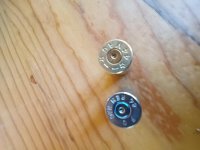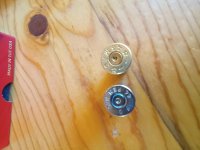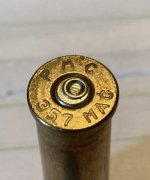- Joined
- Feb 12, 2024
- Messages
- 4
- Reaction score
- 0
Hello, I recently started reloading for a s&w 629. I'm wondering if I'm seeing overpressure signs with my reloads. The picture shows two cases, the one on the left is a factory load - federal premium 240gr hydra-shok JHP. The one on the right is a reload that I did and wondering if that primer is showing signs of overpressure. The case was trimmed to 1.275" and loading with 24gr of h110 with a 240gr Hornady xtp. Primer was Winchester large pistol. COL was 1.609" with a heavy crimp. I'm using a lee hand press with lee deluxe die set. There doesn't seem to be a big difference between the primers, but the reload seems slightly flatter. The reloaded case also had no problem extracting.
Attachments
Last edited:




